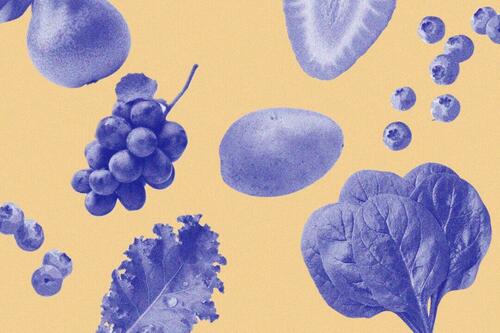
Demystifying The Dirty Dozen: Why Some Fruits and Vegetables Carry More Pesticides
Authored by Cara Michelle Miller via The Epoch Times (emphasis ours),
Every year, the Environmental Working Group’s (EWG) new list causes a stir in the produce aisle—and this time, two newcomers, blackberries and potatoes, have landed on the Dirty Dozen list, prompting many shoppers to give their grocery carts a second look.
 The Epoch TImes/Shutterstock
The Epoch TImes/ShutterstockThe EWG’s updated 2025 Shopper’s Guide to Pesticides in Produce highlights the fruits and vegetables most likely to carry the most pesticide residues.
While the findings offer new insight into pesticide exposure, the report is meant to inform—not alarm.
The EWG Shopper’s Guide is a tool to help people avoid consuming potentially harmful chemicals, Alexa Friedman, senior scientist at EWG, said in a press release. “Everyone should eat more fruits and vegetables—organic or conventional.”
“My goal is to get people to eat more produce, not less,” Elizabeth Shaw, a registered dietitian and author of four books on practical, healthful eating, who was not involved in the study, told The Epoch Times in an email.
Shaw says that fruits and vegetables—organic or not—are still essential for a healthy diet.
Why They Made the List
The Dirty Dozen list highlights fruits and vegetables that tend to carry the highest levels and varieties of pesticide residue, based on federal data.
EWG researchers assessed data from pesticide residue tests conducted by the U.S. Department of Agriculture (USDA) on more than 53,000 samples of 47 fruits and vegetables.
This year, blackberries and potatoes joined the list after testing revealed frequent contamination with chemicals like cypermethrin, a pesticide the Environmental Protection Agency (EPA) classifies as a probable human carcinogen, and chlorpropham, a sprout inhibitor banned in the EU in 2019.
USDA testing found that 93 percent of conventional blackberry samples carried pesticide residues, with an average of four different substances per sample. Potatoes showed chlorpropham in 90 percent of samples tested.
These changes reflect how the EWG ranks pesticide risk. For the first time, the list weighs not just how often pesticides are found or in what amounts—but also how toxic the chemicals are, based on safety thresholds.
“This means we’re not only flagging produce with the most pesticides, we’re also highlighting those with potential health hazards,” Varun Subramaniam, associate scientist at EWG, said in the press release.
The full 2025 list, ranked by pesticide contamination and toxicity, includes spinach, strawberries, kale, grapes, peaches, cherries, nectarines, pears, apples, blackberries, blueberries, and potatoes.
These items often have thin or porous skins that can absorb pesticides more readily, and even washing may not remove all pesticide residues. While peeling can reduce exposure, some chemicals may still be present beneath the surface.
The Clean Fifteen: Safer Picks
For shoppers seeking lower-risk options, the EWG also publishes its Clean Fifteen list—fruits and vegetables with the lowest levels of detectable pesticide residues.
This year’s newcomers include bananas and cauliflower, joining items like avocados, pineapples, onions, and papayas.
These fruits and vegetables are considered “clean” because their thick, inedible skins or outer layers act as natural barriers, limiting pesticide exposure to the edible parts. In the case of cauliflower, its outer leaves—typically removed before cooking—help protect the inner head from pesticide contact, much like the skins of avocados or bananas.
In addition, asparagus, cabbage, watermelon, mangoes, carrots, mushrooms, kiwi, and fresh or frozen sweet corn and sweet peas rounded out the list.
Nearly 60 percent of Clean Fifteen items had no detectable residues at all, and only 16 percent carried two or more pesticides.
Bananas are a staple in children’s diets, so it’s encouraging to see them on the list, noted EWG scientists. Vice president for science, Alexis Temkin, added that “For people looking to reduce pesticide exposure, buying from the Clean Fifteen is a great place to start.”
What We Know About Pesticide Risk
Research has linked certain pesticides to a wide range of health effects, including cancers, hormone disruption, fertility issues, and developmental harm in children.
Children may be more vulnerable to harm from chemicals. A 2024 study showed early-life exposure could impact cognitive development from infancy through adolescence.
Still, Shaw cautions that legal safety limits matter—and most produce clears that bar.
“I work with the nonprofit Alliance for Food and Farming, which supports both organic and conventional growers,” Shaw said. “More than 99 percent of the produce tested by the USDA is below legal safety limits set by the EPA.”
She pointed to data from the USDA’s Pesticide Data Program, which annually analyzes residue levels in foods—especially those eaten by babies and children. The most recent findings showed that even when residues are detected, they’re almost always well under federal safety thresholds.
Smart Shopping, Safer Produce
The EWG’s guide is a tool—not a rulebook.
“Buy what you can afford, be it organic or conventional produce, rinse it, and eat it,” Shaw said. “I think it’s important we put more of a spotlight on numbers and facts [of health benefits].”
She points to large studies showing that eating more fruits and vegetables—regardless of how they’re grown—can significantly lower your risk of chronic disease. One study published in the Journal of Epidemiology & Community Health found that eating seven or more servings a day reduced premature death risk by 42 percent, and lowered cancer and heart disease deaths by 25 percent and 31 percent, respectively.
A peer-reviewed study published in the British Journal of Cancer found no significant difference in cancer rates between middle-aged women who ate organic foods and those who ate conventionally grown produce.
If you want to lower your exposure to pesticides without the expense of going fully organic, experts recommend a few simple prep steps:
- Rinse all produce under running water for at least 15 seconds to remove surface residues, dirt, and microbes.
- Scrub firm-skinned items like potatoes and apples with a clean produce brush. Firm-skinned produce can hold residues even beneath the surface—brushing helps remove more than rinsing alone.
- Peel or trim outer layers from leafy greens like cabbage or lettuce. Pesticides are most concentrated on the outer leaves.
- Soak in warm water to help remove dirt and residues, along with bacteria. This can be especially helpful for produce with crevices or textured surfaces, like berries or broccoli.
- Skip the soap. The U.S. Food and Drug Administration and the USDA guidelines recommend using water only. Soaps and detergents are not approved for produce and may leave harmful residues.
These steps will reduce residues—along with bacteria and dirt that could cause illness.
Shaw’s key message is about keeping produce on the plate—not off it.
“You will do far more harm than good to your body in the name of ‘health’ by taking away important nutrients the body needs from fruits and vegetables if you stop eating them altogether.”
Tyler Durden
Wed, 06/18/2025 – 21:45













